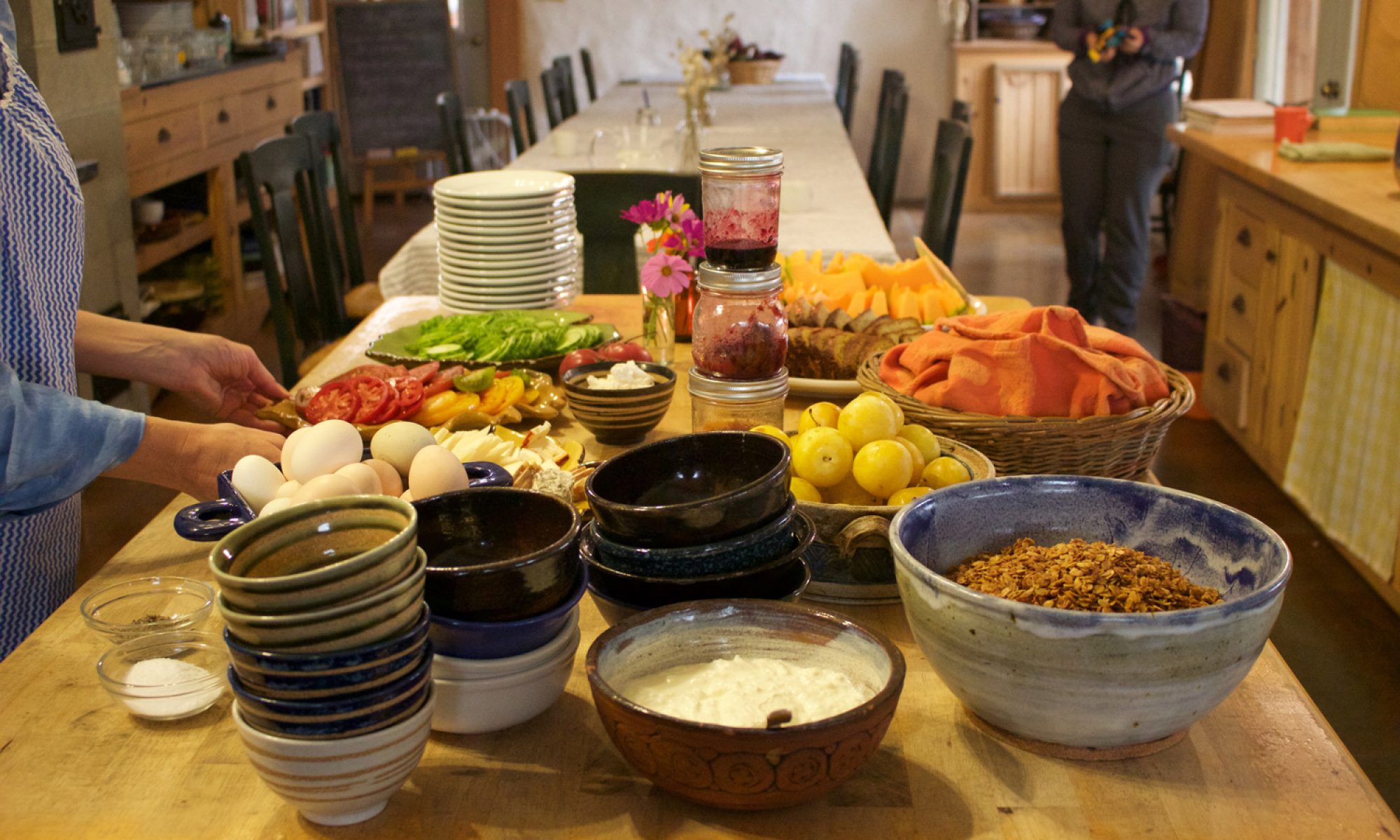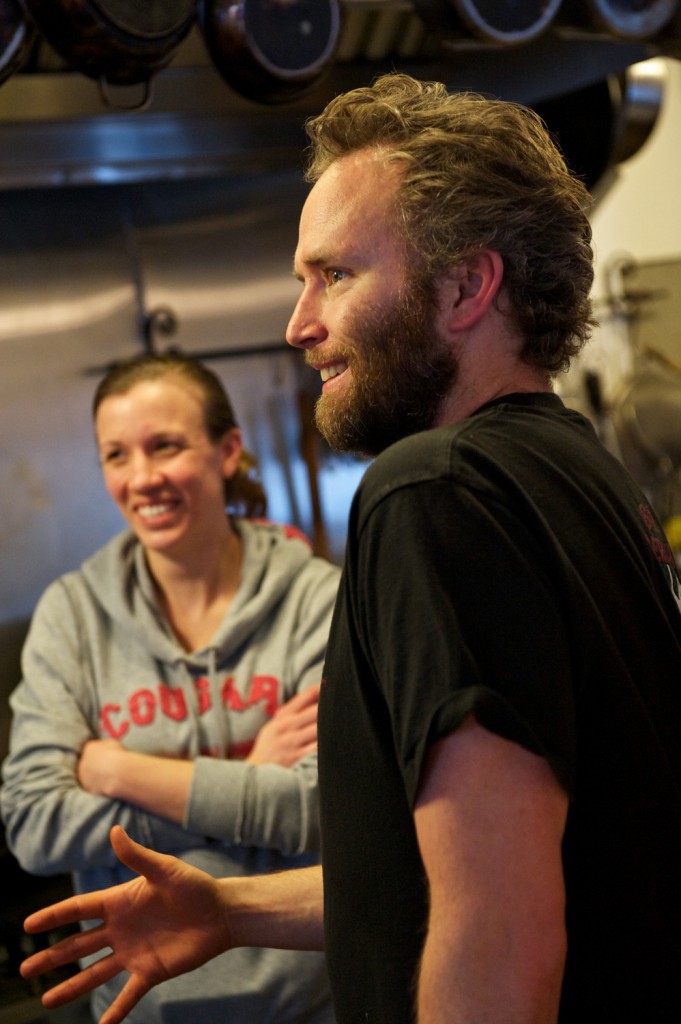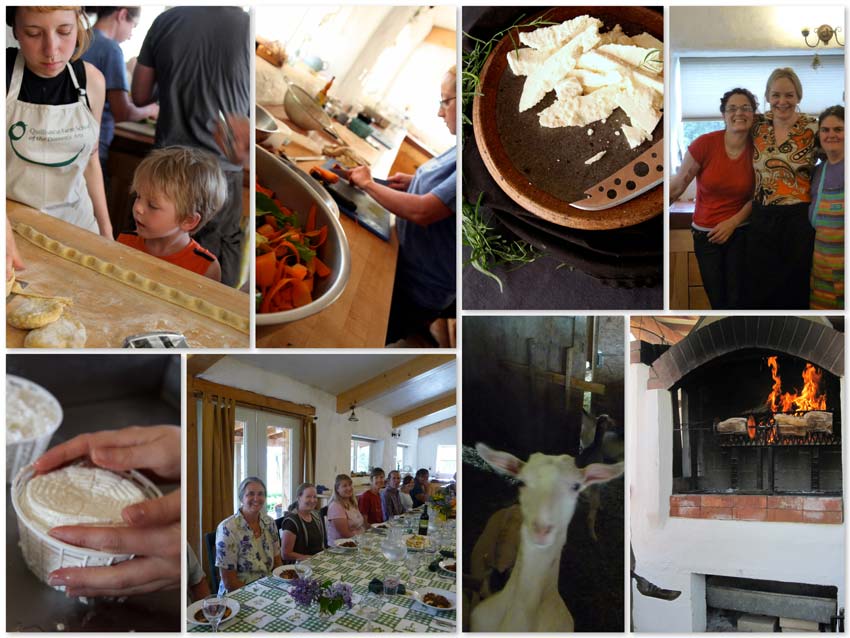Tracy McGeehan shares her memories and reflections from a week at Quillisascut Farm.
“I’ll give them a little less to eat this evening,” said Rick Misterly, the farmer of Quillisascut Farm School for the Domestic Arts, as he gave us all a tour the first Wednesday evening of our stay. “That way, when I show up tomorrow morning at 5:00, they’ll all come running to me, hungry and ready to be fed. It will make it easier to capture my goat of choice and slaughter him.”
Rick is referring to a herd of seven male goats, one of which will be slaughtered for our class, Farm Culinary 101. As students, we will observe the skinning and evisceration of this goat, break it down into its primal cuts, and ultimately dine on it. Nothing of this animal will go to waste. And that is one of many things that we are here to learn – respect for the farmer, the land and how food makes its way to the table.
Quillisascut Farm is in the northeastern corner of Washington, off the Columbia River, near the small town of Rice and located in Pleasant Valley. One of the objectives of this school is to educate food-service professionals about where it all begins – be it live animal, plant or tree. The farm started out in 1987 by making and selling a variety of goat cheese. From the beginning, the intent of Rick and Lora Lea was to educate the community about eating locally and sustainably, long before it was in vogue.
There were nine of us, ready to take on the challenges that lay before us. On Thursday morning, 5:30AM, behind the school, each of us grasping a steaming cup of hot coffee, some with goat’s milk (no coincidence there – cow’s milk was not an option), waiting for Rick to pull up with the tractor, slaughtered goat in tow. The students are never invited to participate in the slaughtering – it’s a matter of respect between Rick and the goat. He has deemed it a personal affair – one in which there is no need for observation. As he pulls up next to the school on this clear, crisp morning, we all stand in respect, a bit somber, sensing his melancholy.
Rick gets right to work, with his Komondor, Libby, the guard dog of the farm, at his side. He begins to skin and eviscerate the goat, a process that takes about two hours. His form is eloquent, his movement fluid and precise, demonstrating such respect for this animal that he has just slaughtered with his bare hands. The innards of this creature fall effortlessly into a wheelbarrow, to be taken up near the garden area and composted. The final step in handling the goat is to saw it in half, readying it to hang in the walk-in for 2 days, before being fabricated and finally cooked and eaten. “Ideally, it would hang for about a week”, Rick remarks, “but for purposes of this class, it will only hang for two days, so you guys can cook with it and see the finished product.” The goat will be eaten as our farewell dinner.
Throughout the process, we ask many questions. Most are questions of general information about the goat, and the process that is taking place. However, one question intrigues me the most. “Is it hard to kill a goat that you know, that you have raised from a kid?” asks a student from Spokane WA. Rick tells us that the night before he slaughters one of his goats, he is not able to sleep very well. “My biggest fear”, he says, “is not being able to kill the goat immediately, causing him stress, which will cause pain and suffering. Once I have slit his neck and he is dead, my fear is gone.” Despite the love and care given to all of these animals on this farm, they are part of an ecosystem that exists here. The residents practice sustainability on a daily basis, leading by example. And these goats are one of many food sources to be eaten.
Saturday is the fabrication of the goat. Fabrication is the process of butchering an animal into its various cuts of meat. Chef Karen (pronounced Karn – it’s Nordic) leads us with this task. She is calm, professional and organized when going about her work. Chef Karen is accustomed to utilizing every part of an animal. Three hotel pans are set up during the fabrication – one for good cuts (loin, rack, shoulder and leg), one for sausage and one for the dogs and cats. The loin and the rack are to be prepared this evening for dinner; the other cuts will end up in the freezer, for future use.
As the dinner nears, the Chef and students are preparing our final dinner together. My contribution is freekeh tabbouleh with cucumbers, carrots, dill, mint, parsley and white wine vinaigrette. Freekeh is still green or under ripe wheat kernels. A local farmer grew this grain as an experiment and gave it to Quillisascut. Also on the menu are blanched green beans with shaved fennel, and a sautéed pigweed made by Chef Rung, a fellow student and native of Thailand. Pigweed in the United States is looked upon as a weed. Its flavor is very similar to spinach.
As you can imagine, the highlight of the meal was goat tenderloin and rack, both of which were roasted in the oven, keeping a light pink interior. The flavor of this meat was surprisingly mild. It was prepared very simply, so that its flavor would not be overlooked or masked by something else. The testicles of the goat were also served that evening. They were pan-fried with a little salt. At first bite, I felt a little squeamish, but powered on. These reminded me of chicken breast, as they were very mild.
While you may not find this meal in Fine Cooking or Saveur magazine, it is quite a feat. Every component was either grown or raised on Quillisascut Farm, or sourced from a nearby farm. With the exception of a few items (EVO, vinegars, dried herbs or spices) participants and residents at the Farm School truly eat locally. With the completion of this meal, I have come full circle. There is still much to be learned about eating locally and sustainably, but I’m a willing student. I was ready to journey home and share my knowledge with anyone willing to listen.


